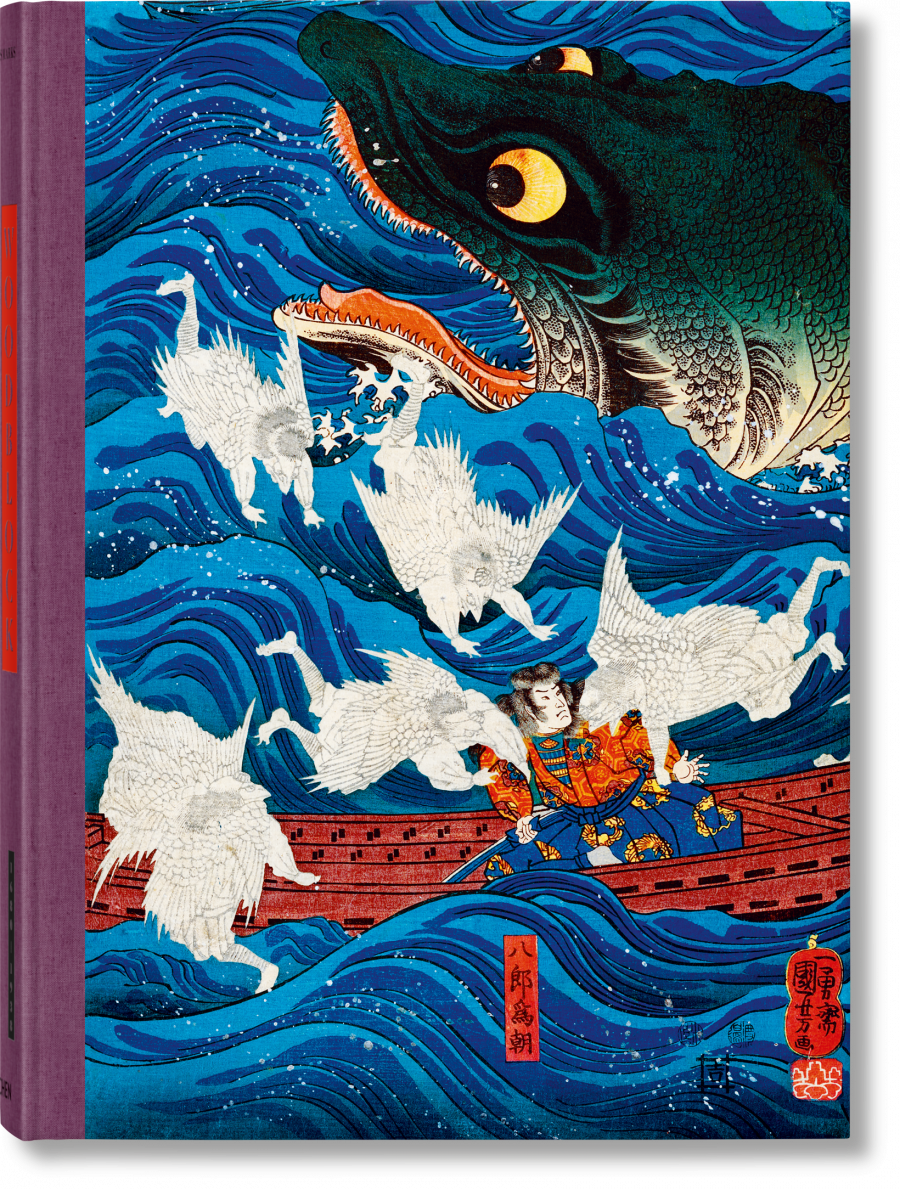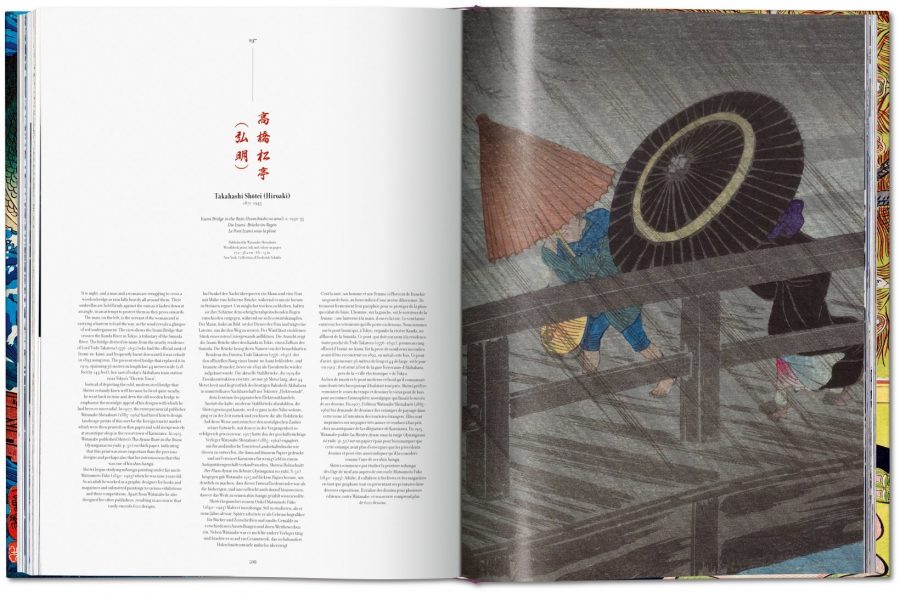[Most Recent Entries] [Calendar View]
Monday, December 23rd, 2019
| Time | Event |
| 9:00a | A Beautiful New Book of Japanese Woodblock Prints: A Visual History of 200 Japanese Masterpieces Created Between 1680 and 1938
Japanese woodblock prints, especially in the style known in Japanese as ukiyo-e, or "pictures of the floating world," portray the social, natural, and supernatural realms in a way no other art form ever has. They also repay the attention you give them, one reason we here on Open Culture have tried to share with you every opportunity to download them — from the archive at Ukiyo-e.org, for example, or at the Library of Congress — and build your own digital collection.
But appreciating Japanese woodblock prints on a screen is one thing, and appreciating them in large-scale reproductions on paper is quite another. At least that's one implicit premise of the book Japanese Woodblock Prints (1680–1938), newly published by Taschen. As a publisher, Taschen has made its formidable name in part by collecting between two covers the lesser-known work of famous artists of the recent past: Andy Warhol's hand-illustrated books, for example, or Salvador Dalí’s cookbook and tarot deck.
Never an outfit to fear accusations of immodesty, Taschen's projects also include "XXL books" like a 500-page, 14-pound volume on Jean-Michel Basquiat. Surpassing even that book in length by more than 200 pages, Japanese Woodblock Prints contains, according to Taschen's official site, an artistic reality where "breathtaking landscapes exist alongside blush-inducing erotica; where demons and otherworldly creatures torment the living; and where sumo wrestlers, kabuki actors, and courtesans are rock stars."
"For this tome, Taschen spent three years reproducing woodblock prints from museums and private collections from around the world," writes Colossal's Andrew Lasane. "Written by Andreas Marks, head of the Japanese and Korean Art Department at the Minneapolis Institute of Art, the book is divided chronologically into seven chapters beginning with the 17th century early masters and concluding with the Shin-hanga movement." (That last is a late 19th- and early 20th-century woodblock style, in which we once featured renderings of Hayao Miyazaki's characters.)
No matter our temporal and cultural distance from the Japanese masters of ukiyo-e, we've nearly all been captivated by their work at one time or another, most often when we run across pieces of it online. With Japanese Woodblock Prints, Taschen means to get those of us who prefer print even more captivated — and at the same time, to teach us more than a little about the cultural and historical context of all these landscapes, cityscapes, monsters, beauties, and historical figures at which we marvel. If you want to pick up a copy of this artistic work, you can make a purchase on the Taschen website or on Amazon.
via Colossal Related Content: Enter a Digital Archive of 213,000+ Beautiful Japanese Woodblock Prints Download 2,500 Beautiful Woodblock Prints and Drawings by Japanese Masters (1600-1915) Download Hundreds of 19th-Century Japanese Woodblock Prints by Masters of the Tradition 19th Century Japanese Woodblock Prints Creatively Illustrate the Inner Workings of the Human Body Based in Seoul, Colin Marshall writes and broadcasts on cities, language, and culture. His projects include the book The Stateless City: a Walk through 21st-Century Los Angeles and the video series The City in Cinema. Follow him on Twitter at @colinmarshall or on Facebook. A Beautiful New Book of Japanese Woodblock Prints: A Visual History of 200 Japanese Masterpieces Created Between 1680 and 1938 is a post from: Open Culture. Follow us on Facebook, Twitter, and Google Plus, or get our Daily Email. And don't miss our big collections of Free Online Courses, Free Online Movies, Free eBooks, Free Audio Books, Free Foreign Language Lessons, and MOOCs. |
| 12:00p | Richard Feynman’s “Lost Lecture:” An Animated Retelling Nobel prize-winning physicist Richard Feynman is “famous in a number of dimensions,” says science and math explainer Grant Sanderson of the YouTube channel 3blue1brown in the video above. “To scientists, he’s a giant of 20th century physics… to the public, he’s a refreshing contradiction to the stereotypes about physicists: a safe-cracking, bongo-playing, mildly philandering non-conformist.” Feynman is also famous, or infamous, for his role in the Manhattan Project and the building of the first atomic bomb, after which the FBI kept tabs on him to make sure he wouldn't, like his colleague Klaus Fuchs, turn over nuclear secrets to the Soviets. He may have led an exceptionally eventful life for an academic scientist, but to his students, he was first and foremost “an exceptionally skillful teacher… for his uncanny ability to make complicated topics feel natural and approachable.” Feynman’s teaching has since influenced millions of readers of his wildly popular memoirs and his lecture series, recorded at Caltech and published in three volumes in the early 1960s. (Also see his famous course taught at Cornell.) For decades, Feynman fans could list offhand several examples of the physicist’s acumen for explaining complex ideas in simple, but not simplistic, terms. But it wasn’t until the mid-nineties that the public had access to one of the finest of his Caltech lectures. Discovered in the 1990s and first published in 1996, the “lost lecture”—titled “The Motion of the Planets Around the Sun”—“uses nothing more than advanced high school geometry to explain why the planets orbit the sun elliptically rather than in perfect circles," as the Amazon description summarizes. You can purchase a copy for yourself, or hear it Feynman deliver for free just below. Feynman gave the talk as the guest speaker in a 1964 freshman physics class. He addresses them, he says, “just for the fun of it"; none of the material would be on the test. Nevertheless, he ended up hosting an informal 20-minute Q&A afterwards. Given his audience, Feynman assumes only the most basic prior knowledge of the subject: an explanation for why the planets make elliptical orbit around the sun. “It ultimately has to do with the inverse square law,” says Sanderson, “but why?” Part of the problem with the lecture, as its discoverers David and Judith Goodstein—husband and wife physicist and archivist at Caltech—found, involves Feynman’s extensive reference to figures he draws on the blackboard. It took some time for the two to dig these diagrams up in a set of class notes. In Sanderson’s video at the top, we get something perhaps even better: animated physical representations of the mathematics that determine planetary motion. We need not know this math in depth to grasp what Feynman calls his “elementary” explanation. “Elementary” in this case, despite common usage, does not mean “easy,” Feynman says. It means “that very little is required to know ahead of time in order to understand it, except to have an infinite amount of intelligence.” That last part is a typical bit of humor. Even those of who haven’t pursued math or physics much beyond the high school level can learn the basic outlines of planetary motion in Feynman’s witty lecture, supplemented by the video visual aids Sanderson offers at the top. Related Content: ‘The Character of Physical Law’: Richard Feynman’s Legendary Course Presented at Cornell, 1964 The Richard Feynman Trilogy: The Physicist Captured in Three Films Learn How Richard Feynman Cracked the Safes with Atomic Secrets at Los Alamos Richard Feynman Plays the Bongos Josh Jones is a writer and musician based in Durham, NC. Follow him at @jdmagness Richard Feynman’s “Lost Lecture:” An Animated Retelling is a post from: Open Culture. Follow us on Facebook, Twitter, and Google Plus, or get our Daily Email. And don't miss our big collections of Free Online Courses, Free Online Movies, Free eBooks, Free Audio Books, Free Foreign Language Lessons, and MOOCs. |
| 3:00p | Hear the Trippy Mystical Sounds of Giant Gongs Growing up I thought there were only two uses for gongs. One was for making one large bonnnnnnng sound for something important, like the announcement of a royal banquet or the beginning of a J. Arthur Rank production. The other was as a weapon against cartoon animals--it would make a funny sound and their heads would be turned into a pancake. How was I to know there was so much more to gongs, especially 80-inch wide gongs that cost around $27,000? Thank goodness for YouTube, then. The above video features Sven aka Gong Master Sven aka Paiste Gong Master Sven (it’s not very clear in the description) very gingerly playing this monster symphonic gong, coaxing out of it menacing, echoing groans and wails straight out of a horror movie. Just a gentle stroke can cause the metal to vibrate and feed back onto itself. Using a smaller mallet produces sounds like whale songs. That something so large can make such a stunning array of tones, and react to such delicacy is fascinating. (Watch with headphones on or a good sound system, by the way). If that whets your whistle, here’s more gong action with musician Bear Love, who manages to make his gong sound like something out of science fiction, incredibly creepy. If there’s a ghost story movie out there with a one-gong soundtrack, I’d believe it. Michael Bettine plays the same Paiste gong in a more familiar way, by whacking it with a big mallet. It’s impressive, and he doesn’t really hit it that hard. “You can feel your internal organs being massaged by the vibrations,” he says. Finally, Tom Soltron Czartoryski, slims it down to a 62 inch “earth gong” with its array of indentations, and creates a nearly 10 minute ambient work, which is one expansive dose of space music. Groovy and sometimes stressful, fascinating and all-encompassing. Enjoy! (Note to self: Resolve to find a local giant gong and have a go.) via Kottke.org Related Content: A Modern Drummer Plays a Rock Gong, a Percussion Instrument from Prehistoric Times Hear a 9,000 Year Old Flute—the World’s Oldest Playable Instrument—Get Played Again Punk Dulcimer: The Ramones’ “I Wanna Be Sedated” Played on the Dulcimer Ted Mills is a freelance writer on the arts who currently hosts the artist interview-based FunkZone Podcast and is the producer of KCRW's Curious Coast. You can also follow him on Twitter at @tedmills, read his other arts writing at tedmills.com and/or watch his films here. Hear the Trippy Mystical Sounds of Giant Gongs is a post from: Open Culture. Follow us on Facebook, Twitter, and Google Plus, or get our Daily Email. And don't miss our big collections of Free Online Courses, Free Online Movies, Free eBooks, Free Audio Books, Free Foreign Language Lessons, and MOOCs. |
| << Previous Day |
2019/12/23 [Calendar] |
Next Day >> |











